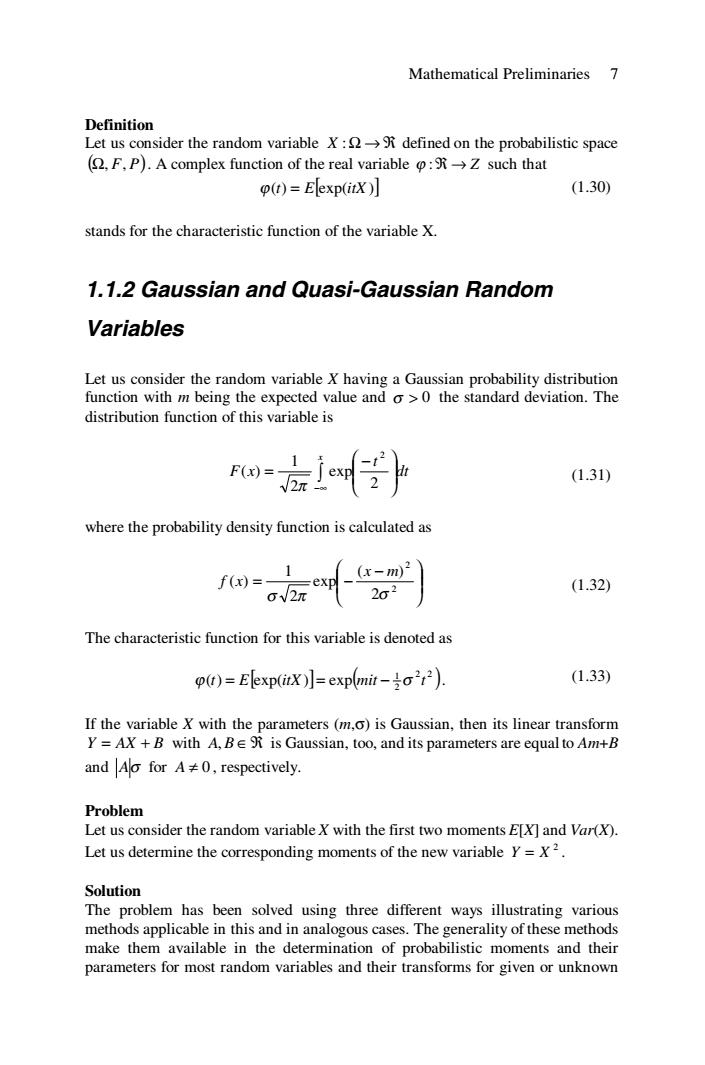正在加载图片...

Mathematical Preliminaries 7 Definition Let us consider the random variable X:defined on the probabilistic space (2,F,P).A complex function of the real variable o:Z such that p(t)=Eexp(itx】 (1.30) stands for the characteristic function of the variable X. 1.1.2 Gaussian and Quasi-Gaussian Random Variables Let us consider the random variable X having a Gaussian probability distribution function with m being the expected value and o >0 the standard deviation.The distribution function of this variable is (1.31) where the probability density function is calculated as f)= exp (r-m)2 202 (1.32) The characteristic function for this variable is denoted as o(t)=Elexp(itx)]=exp(mit-2). (1.33) If the variable X with the parameters(m,o)is Gaussian,then its linear transform Y=AX +B with A,Be is Gaussian,too,and its parameters are equal to Am+B and Ao for A≠0,respectively. Problem Let us consider the random variable X with the first two moments E[X]and Var(X). Let us determine the corresponding moments of the new variable Y=X2. Solution The problem has been solved using three different ways illustrating various methods applicable in this and in analogous cases.The generality of these methods make them available in the determination of probabilistic moments and their parameters for most random variables and their transforms for given or unknownMathematical Preliminaries 7 Definition Let us consider the random variable X :Ω → ℜ defined on the probabilistic space ( ) Ω, F, P . A complex function of the real variable ϕ :ℜ → Z such that ϕ(t) = E[ ] exp(itX ) (1.30) stands for the characteristic function of the variable X. 1.1.2 Gaussian and Quasi-Gaussian Random Variables Let us consider the random variable X having a Gaussian probability distribution function with m being the expected value and 0 σ > the standard deviation. The distribution function of this variable is dt t F x x ∫ −∞ ⎟ ⎟ ⎠ ⎞ ⎜ ⎜ ⎝ ⎛ − = 2 exp 2 1 ( ) 2 π (1.31) where the probability density function is calculated as ⎟ ⎟ ⎠ ⎞ ⎜ ⎜ ⎝ ⎛ − = − 2 2 2 ( ) exp 2 1 ( ) σ π σ x m f x (1.32) The characteristic function for this variable is denoted as [ ] ( ) 2 2 2 1 ϕ(t) = E exp(itX ) = exp mit − σ t . (1.33) If the variable X with the parameters (m,σ) is Gaussian, then its linear transform Y = AX + B with A, is Gaussian, too, and its parameters are equal to B ∈ℜ Am+B and Aσ for 0 A ≠ , respectively. Problem Let us consider the random variable X with the first two moments E[X] and Var(X). Let us determine the corresponding moments of the new variable 2 Y = X . Solution The problem has been solved using three different ways illustrating various methods applicable in this and in analogous cases. The generality of these methods make them available in the determination of probabilistic moments and their parameters for most random variables and their transforms for given or unknown